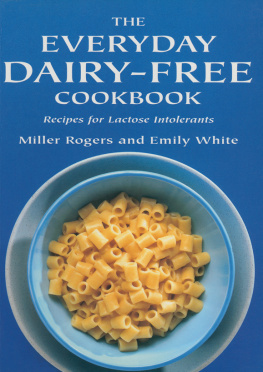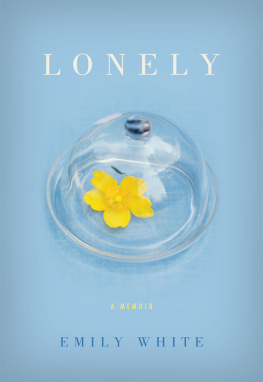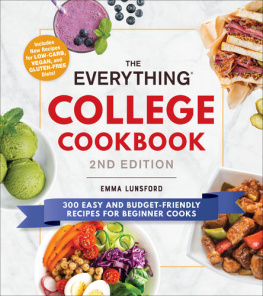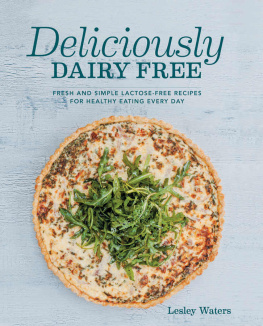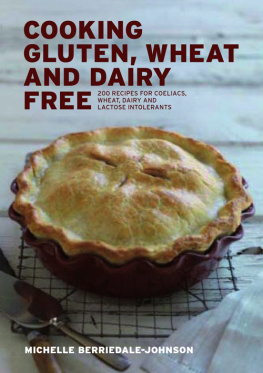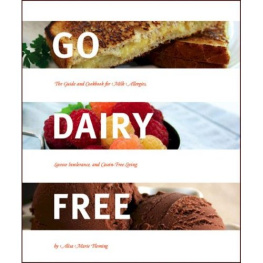THE
EVERYDAY
DAIRY-FREE
COOKBOOK
Recipes for Lactose Intolerants
MILLER ROGERS AND EMILY WHITE
GRUB STREET LONDON
Published by Grub Street
4 Rainham Close
London SW11 6SS
Email post@grubstreet.co.uk
www.grubstreet.co.uk
Copyright this edition Grub Street 2001
Text copyright Miller Rogers 2001
Recipes Emily White 2001
Reprinted 2006, 2008, 2010, 2011
British Library Cataloguing in Publication Data
Rogers, Miller
The Everyday Dairy-Free Cookbook
1. Milk-free diet recipes
I. Title II. White, Emily
641.563
ISBN 978 1 910690 92 5
All rights reserved. No part of this publication may be reproduced, stored in a retrieval system, or transmitted in any form or by any means, electronic, mechanical, photocopying, recording, or otherwise, without the prior permission of the publisher.
Cover design: Hugh Adam
Cover photograph: Simon Smith
Photography: Michelle Garrett
Typesetting by Pearl Graphics, Hemel Hempstead
Printed and bound in Great Britain by MPG, Bodmin, Cornwall
The publishers would like to thank TTC
(01773 520205, sales@tctabletop.com)
for kindly supplying china, linen and cutlery for photography
Note: When making any of the recipes in this book, only follow one set of measures at a time (i.e. metric or imperial).
Grub Street uses FSC (Forestry Stewardship Council) paper for its books
Contents
RECIPES
Diagnosis of any allergy or intolerance can be a daunting prospect for the home cook, and dietary information can be difficult to come by, especially finding tempting everyday recipes, which have to omit some basic ingredient. This useful and informative book with its combination of sound nutritional advice and collection of delicious, interesting family dishes will prove an invaluable guide to those individuals and parents who are having to cater, perhaps for the first time, for themselves or members of their family, diagnosed as lactose intolerant. This cookery book is a collaboration between Emily White, trained chef, restaurateur and cook and Miller Rogers, a nutritional therapist with a London practice.
Emily White is the daughter of two well-known restaurateurs in Suffolk. She trained at Prue Leiths cookery school and this was followed by several years working as a chef in London at various wine bars and restaurants. In the early 1990s she moved back to Suffolk and set up a small catering company. Eventually she took over as manager of her parents busy restaurant in Colchester The Warehouse Brasserie and then cooked and managed their next venture, The Red Onion Bistro in Sudbury. She is presently helping her brother with his popular pub/restaurant The Treble Tile in West Bergholt. With a husband and two young school-age children to cook for she has become increasingly interested in centring her cooking around nutritious, healthy food and believes it to be a sensible step to cut down on the intake of dairy produce. She has used her experience of commercial and domestic catering to create these dairy-free recipes which should help you stay on your elimination diet without feeling deprived.
Miller Rogers was brought up in a household where eczema, asthma and hay fever were prevalent. She became interested in the effects of food on the body when she was diagnosed with allergies and intolerances and as a result was brought up with the strong smell of goats milk emanating from the fridge. She had the idea of setting up a health food shop or restaurant that would cater for those with food restrictions and so studied for a degree in Catering and Retail Management. After gaining experience in retail catering outlets such as Cranks, she was drawn into film production. Eight years later as a Production Manager having problems eating a restricted diet on location, she went to see a nutritional therapist. When she finally stopped eating dairy products there was a significant improvement in her condition. As her allergies started to improve and she saw the benefit of a nutritional understanding she decided to study, firstly part-time and then full-time, nutritional therapy, herself. She now has her own practice ( www.difficultdiners.com ) and is presently setting up a programme of nutritional education for teenagers at a local health centre.
How this book will help
The word allergy is bandied around so often and appears to be the root cause of so many symptoms that it seems we have been overtaken by an epidemic of allergies. People claim to be allergic to anything from sunlight, pollution, mobile phones, any and all foods, and even their bosses! Some reactions are more obvious like a peanut allergy causing anaphylactic shock, but if the symptoms are more obscure how do we know if we are allergic to it? Are we actually more allergic than we used to be or are we more aware of allergic symptoms and consequently notice them more? There has certainly been an increase in magazine and newspaper articles about allergies.
As a milk allergy is one of the top two most common allergies, this book has been designed to help anyone beginning (or needing encouragement to maintain) a dairy- or lactose-free diet. We will start by explaining what a milk allergy actually is, and how it differs from a lactose intolerance, then we will go through the different symptoms before describing what following a dairy- and lactose-free diet involves. We will look at foods that can be used to replace dairy products, and what non-dairy eaters need to be aware of with calcium and protein levels in their diet. We have put together some handy hints for eating out, lunch at work, or dinner at a local restaurant; and a Replacement Ingredients section for help with shopping and advice on the many different products that have grown up around the non-dairy market. There are some more vulnerable groups in the population, for example babies, children, teenagers and pregnant women, who need to make sure they are getting an adequate nutritional intake, so if this is relevant to you please read the notes about calcium intake. There are also people who follow a dairy-free diet but are not allergic to dairy nor lactose intolerant, so we have added a few comments about fat content and a list of the benefits of avoiding dairy produce. Lastly, we have included some suggested meals and notes on cooking and preparing recipes.
This book aims to show that dairy-free meals need not be dull or boring, but can be every bit as tasty as a meal that includes dairy products. However, we do need to be realistic; we are missing out a whole food category, so whilst some recipes use dairy alternatives, others are designed to stimulate imaginative cooking without the use of dairy substitutes. If you have any concerns about following a dairy-free diet or have a condition that may be affected by your diet, it is important you consult your doctor before starting the diet.
Incidence and Increase of Dairy Allergy and Intolerance
In 1997 the brewers Guinness, advertised that 88.2% of statistics are made up on the spot. In actual fact it was a quote from Vic Reeves, but nonetheless it is with great trepidation that I pass on any statistics at all. As a Nutritional Therapist I have been taught to question statistics that are surprising, unexplained or newsworthy. Had the full trial been published? Had it been conducted properly? Was there something left unreported that would explain the statistic?
Although the government has not got exact figures, the National Diet and Nutrition Survey produced by the Stationery Office in April 2000 found that 9% of boys and 13% of girls reported having an allergy to one or more foods; whilst 4% and 6% (boys and girls respectively) were reported to have their allergies diagnosed by a doctor. In the US dairy allergy and intolerance is estimated to have an incidence of 5% of the population, and as they have a fairly similar ethnic mix to us, our figures are likely to be similar.
Next page
